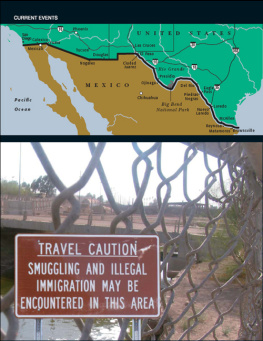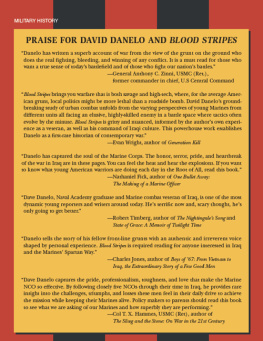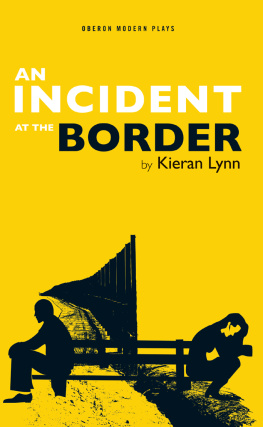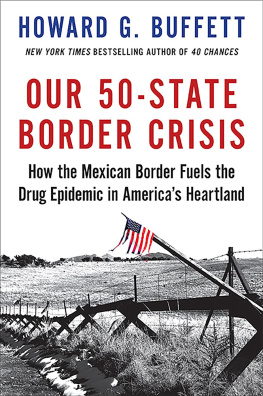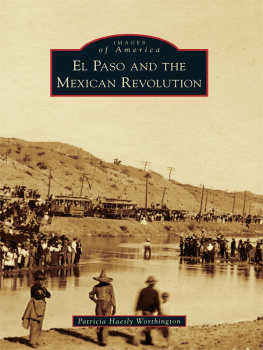Danelo - The Border: Exploring the U.S.-Mexican Divide
Here you can read online Danelo - The Border: Exploring the U.S.-Mexican Divide full text of the book (entire story) in english for free. Download pdf and epub, get meaning, cover and reviews about this ebook. City: Mechanicsburg, year: 2014, publisher: Stackpole Books (NBN), genre: Detective and thriller. Description of the work, (preface) as well as reviews are available. Best literature library LitArk.com created for fans of good reading and offers a wide selection of genres:
Romance novel
Science fiction
Adventure
Detective
Science
History
Home and family
Prose
Art
Politics
Computer
Non-fiction
Religion
Business
Children
Humor
Choose a favorite category and find really read worthwhile books. Enjoy immersion in the world of imagination, feel the emotions of the characters or learn something new for yourself, make an fascinating discovery.
- Book:The Border: Exploring the U.S.-Mexican Divide
- Author:
- Publisher:Stackpole Books (NBN)
- Genre:
- Year:2014
- City:Mechanicsburg
- Rating:4 / 5
- Favourites:Add to favourites
- Your mark:
- 80
- 1
- 2
- 3
- 4
- 5
The Border: Exploring the U.S.-Mexican Divide: summary, description and annotation
We offer to read an annotation, description, summary or preface (depends on what the author of the book "The Border: Exploring the U.S.-Mexican Divide" wrote himself). If you haven't found the necessary information about the book — write in the comments, we will try to find it.
Danelo: author's other books
Who wrote The Border: Exploring the U.S.-Mexican Divide? Find out the surname, the name of the author of the book and a list of all author's works by series.
The Border: Exploring the U.S.-Mexican Divide — read online for free the complete book (whole text) full work
Below is the text of the book, divided by pages. System saving the place of the last page read, allows you to conveniently read the book "The Border: Exploring the U.S.-Mexican Divide" online for free, without having to search again every time where you left off. Put a bookmark, and you can go to the page where you finished reading at any time.
Font size:
Interval:
Bookmark:

THE BORDER
THE BORDER
EXPLORING THE U.S.-MEXICAN DIVIDE
DAVID J. DANELO
STACKPOLE
BOOKS
Copyright 2008 by David J. Danelo
Published by
STACKPOLE BOOKS
5067 Ritter Road
Mechanicsburg, PA 17055
www.stackpolebooks.com
All rights reserved, including the right to reproduce this book or portions thereof in any form or by any means, electronic or mechanical, including photocopying, recording, or by any information storage and retrieval system, without permission in writing from the publisher. All inquiries should be addressed to Stackpole Books, 5067 Ritter Road, Mechanicsburg, PA 17055.
Printed in the United States of America
10 9 8 7 6 5 4 3 2 1
FIRST EDITION
Library of Congress Cataloging-in-Publication Data
Danelo, David J.
The border : exploring the U.S.-Mexican divide / by David J. Danelo. 1st ed.
p. cm.
Includes bibliographical references and index.
ISBN-13: 978-0-8117-0393-2
ISBN-10: 0-8117-0393-2
1. Mexican-American Border RegionDescription and travel. 2. Danelo, David J.TravelMexican-American Border Region. 3. Mexican-American Border RegionHistory. 4. Mexican-American Border RegionSocial conditions. 5. Mexican-American Border RegionEconomic conditions. 6. Border patrolsMexican-American Border Region. 7. Illegal aliensMexican-American Border Region. 8. Drug trafficMexican-American Border Region. 9. SmugglingMexican-American Border Region. 10. BorderlandsUnited States. 11. BorderlandsMexico. I. Title.
F787.D36 2008
917.2'10484dc22
2008009887
eBook ISBN: 978-0-8117-4022-7
To our grandparents, but especially Joseph & Yolanda Danelo Melvin & Selena Thompson
and
In memory of my cousin Mario Danelo
PROLOGUE
T he border between the United States and Mexico is the most frequently traversed national boundary in the world. Over 250 million people legally transit the U.S.-Mexico border each year. An unknown numberperhaps as many as 10 milliondo so beyond the law. For decades, we have not been in complete control of our borders, said President George Bush in May 2007, when advocating an immigration reform bill that stalled in Congress. The president added that many have lost faith in the government's ability to even defend the border at all.
In 2007, I spent three months navigating the 1,951.63 miles of the U.S.-Mexico border. I went from the easternmost point, a spit of beach south of Boca Chica, Texas, to Border Field State Park, California, where a rusty fence spills into the Pacific Ocean at the border's western limit. I wandered from Brownsville to San Diego and Matamoros to Tijuana. This can be hazardous country for curious writers; in recent years, journalists have been intimidated, threatened, and even shot along the line that Mexicans call la frontera. Thanks to good fortune and some good advice, I emerged unscathed.
Is it possible to secure one of the most complex borders on the planet? On my first road trip in May, the same month that President Bush was arguing for immigration reform legislation that Congress would eventually reject, I tried to answer this question for myself. Beyond security, I had also wanted to make sense of the border; to find some logical, empirical reason beyond the statistics why McAllen and Laredo were bustling and prospering, why Douglas and Nogales were empty and corrupt, and why the cross-border urbanization of El Paso/Ciudad Jurez had evolved so differently than San Diego/Tijuana.
I talked with small business owners as well as community organizers who framed immigration law, border security, and the North American Free Trade Agreement through the lens of their own experiences. I met a Mexican tourism official who said he had spent almost two decades in jail for murder. I spent a day with three Catholic humanitarians who drop backpacks filled with water and medical supplies along trails in an effort to relieve suffering in the Arizona desert. I watched drugs being smuggled over the border in Nogales.
I wanted to know what the border was, but I found myself stymied each time I attempted to draw conclusions. I returned home with more questions than answers. I consulted a fellow writer for advice, who, in a single-sentence e-mail worthy of an oracle, illustrated both my problem and its solution: Do not understand the border too quickly.
Fortified with that Zen, I plunged back in. The second trip in August and September took me back and forth along the border twice. I met a middle school principal whose students say the pledge of allegiance to the United States in both English and Spanish. I had coffee with the president of the Minutemen Civil Defense Corps. I was pulled over for speeding by Sheriff Ronny Dodson, whose jurisdiction includes 182 miles of border that is routinely violated by drug cartels and a town whose democratically elected mayor is a beer-drinking goat.
I took an unusual route for a gringo in reporting this story. My background as an Annapolis graduate, Marine Corps officer, and Iraq veteran caused me to reflexively examine the border as a tactical problem. My journalism forays to Vietnam, the Horn of Africa, and Iraq made me see it as an academic and legal one. Having spent much of my youth in San Antonio, I'm comfortable with Cinco de Mayo celebrations, enjoy mariachis, and am thoroughly fluent in Spanglish. S, seorita.. Dos fajitas, por favor. Gracias. Unlike some gringos, the growing Latino population in the U.S. does not cause me grave concern.
My slow, poorly accented Spanish should have been a liability, but it turned out to be an asset for the man-on-the-street reporting I did along la frontera. Respect, gesture, and appearance are more universal as communication tools than words. With my big smile, broad shoulders, and a shaved head, the Mexicans I spoke with did not seem to believe I was a writer. They thought I was a businessman's bodyguard, an athlete on vacation, or a hit man. In much of Mexico, those professions are more popular, and safer, than investigative journalism.
There is no other place like it on the planet: this 1,952 mile strip of river and earth where the developed world meets the developing; where rich meets poor; where law can mean so much on one side and so little on another. In some regions, the border is a cultural estuary; 12 million binational residents produce a diverse blend, and the biological fusion becomes impossible to cleanly separate. Others could not seem more dividedby class, by economics, by their legal system. Some Mexican cities survive on the garish border party scene; the (barely enforced) drinking age in Mexico is eighteen. Others have established a thriving middle class through windfalls from NAFTA. Some have become hubs for smuggling marijuana, heroin, and cocaine. Others remain hovels of poverty.
When they flee, they run north. From 2000-2005, the United States accepted more migrants, legally and illegally, than any other country in the world. During those five years, according to the United Nations Population Division, an average of 1.3 million, the majority from Mexico, drifted annually into the United States. By 2007, one in eight people37.9 millionliving in the U.S. was an immigrant. About half had arrived illegally. The runner-up for immigration, Spain, logged a comparatively distant 569,000 migrants per year. No other country came close.
For every person who emigrates, another is not so lucky. In the same five-year period, the U.S. Border Patrol apprehended an average of 1.1 million per year attempting to sneak into the United States from Mexicomore arrests than any other law enforcement organization in the world. Known as
Font size:
Interval:
Bookmark:
Similar books «The Border: Exploring the U.S.-Mexican Divide»
Look at similar books to The Border: Exploring the U.S.-Mexican Divide. We have selected literature similar in name and meaning in the hope of providing readers with more options to find new, interesting, not yet read works.
Discussion, reviews of the book The Border: Exploring the U.S.-Mexican Divide and just readers' own opinions. Leave your comments, write what you think about the work, its meaning or the main characters. Specify what exactly you liked and what you didn't like, and why you think so.

